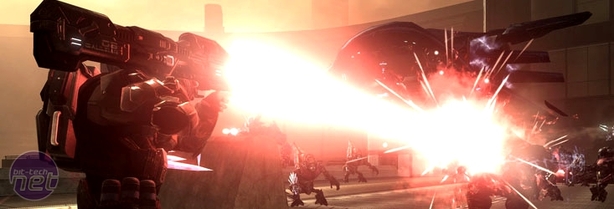
Function over Framework
Maybe we are being a little cynical though because, to be totally fair, Halo 3: ODST can’t be honestly accused of being a bad game or even having a bad story line. The action, if judged on its own merits, is still pretty strong and the plotline is obviously built around the Lost mentality of keeping you guessing what’s coming next. You can love it or hate it for that, but you can’t easily ignore it.The problem is simply that it’s all got predictable by this point. The idea of hunting around for evidence of your unit’s passing manages to feel both at odds with the Halo mentality, but also completely expected.
Likewise, the characters are nearly all obvious stereotypical archetypes – the honourable but grumpy commander who has romance issues with the attractive, but stand-offish intelligence operative. While their premise and dialog is bland to the point of being marketable as an alternative to rolled oats though, the characters manage to somehow maintain some empathy and interest through their actors. Or maybe we’re just biased in Captain Mal’s favour – either way the casting was clever of Bungie.
What we’re less ambivalent of are some of the smaller gameplay tweaks which help breath a little bit of fresh air into Halo – even though the emphasis is on it being only a little breath. The new visor system is our favourite new addition, which helps to highlight enemies and allies in the dark streets of New Mombasa, as well as the streets themselves. It’s not so much a nightvision mode as an edge detector and it proves useful despite the limited range, especially in the early or indoor sections of the game where it’s often annoyingly dark.
The city itself is a notable addition to the game too, as the sparsely populated parks are uncommonly eerie at night and the new Jazz-influenced soundtrack helps to create an enjoyably uncomfortable sensation of loneliness and abandonment in the early segments. When you’re journeying through evacuated apartment buildings in search of clues, be they spent shell casings or bloodstains, then the game does build a certain noir-ish ambience that’s new for the series.
Unfortunately, the gentle momentum of that mood is usually shattered moments later when you round the corner and are faced with Covenant encampments or heavy forces that you’ll have to take down. You can’t just charge in and tackle them head-on either most of the time, so established Halo fans may need to die a few times before they cotton on to the fact that The Rookie isn’t a super-powered Spartan. His health won’t recharge when you hop around cover, so you’ll need to play a bit more carefully – though taking the battle to four-player co-op does make things a mite easier.
One thing that does work pretty well though is the fact that the city of New Mombasa isn’t a linear or confined place, meaning you can tackle the flashbacks in whichever order you want. Be warned though – we found that the game pretty much required you to use the new Visor and map systems to find some of the clues, as it’s not always entirely clear what you’re supposed to be looking for, especially if you pass them in the midst of a gunfight.
Fortunately, while Bungie may have stumbled a bit when it comes to create anything truly original or wholly interesting to base ODST on, the core action and the functional elements of the level design are still fantastic. Fans of the series who are solely interested in the fluidity of the action and the ease with which you can jump in and play, rather than the story, will be thoroughly satisfied with how the game feels and is balanced.

MSI MPG Velox 100R Chassis Review
October 14 2021 | 15:04











Want to comment? Please log in.